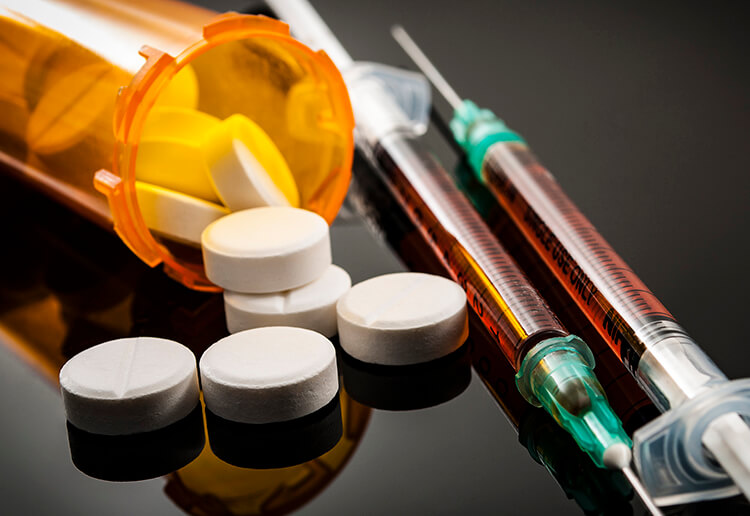By Kristie Campbell

In this day and age, it is difficult to go through an entire day without hearing some mention of the opioid epidemic in the United States. Most recently it has been reported that Americans have a greater chance of dying by accidental opioid overdose than in a motor vehicle crash. And what’s more alarming than that is that despite the overwhelming presence of opioids and their risks in the national media, most people do not understand how these statistics and risks directly affect them. Opioids are, for the most part, legally prescribed by physicians, so people who take them often don’t feel that these statistics apply to them.
Opioids are substances that act on opioid receptors to produce morphine-like effects. Medically they are primarily used for pain relief. They interrupt the pain messages to the brain by slowing down the speed of those messages. Common types of opioids include Buprenorphine, Codeine, Fentanyl, Heroin, Hydromorphone, Methadone, Morphine, Opium, Oxycodone, Pethidine, Tapentadol, Tramadol, and Vicodin. Opioid medications are sold under many different brand names so ask your doctor or pharmacist if you can’t tell by checking the ingredients on the package. Not only do they come in many types, but they also come in different forms, including tablets, capsules, suppositories, soluble tablets and films, powders, syrups, cough medicines, liquids for injection, and skin patches.
The way that opioids work is that they bind to and activate opioid receptors on cells located in many areas of the brain, spinal cord, and other organs in the body, especially those involved in feelings of pain and pleasure. When opioids attach to these receptors, they block pain signals sent from the brain to the body and release large amounts of dopamine throughout the body. This release can strongly reinforce the act of taking the drug, making the user want to repeat the experience.
One of the most well-known side effects of opioids is addiction. Opioids can make people feel very relaxed and “high”, which can be dangerous because it leads to overdoses and death. They are so addictive because they affect the brain’s reward system by releasing large amounts of dopamine into the user’s system. It may also cause the user to take the medication for other reasons than prescribed, for example, to experience euphoria instead of for pain relief. As this happens in an increasing amount, people depend on the high. However, when those effects subside, it causes the user to want more, or take action to get more at whatever the cost. Opioid addiction is a complex psychological and physical inability to stop use, even though it causes harm. Stopping use usually causes physical symptoms but also can cause changes in behavior.
In addition to addiction, however, there are two other very important terms to discuss in the opioid epidemic: dependence and tolerance. Dependence should be distinctly characterized by the ability of the body to develop a need for medication and adjust to increasing levels of that medication, even going through physical withdrawals when the medication is stopped. One difference between addiction and dependence is that addiction causes the user to modify their behaviors in order to obtain a greater high. Tolerance is simply the human body becoming accustomed to the medication. Patients exposed to opioid medications for years will report that the medication is no longer as effective as it used to be.
One of the most common misconceptions of opioid addiction is that if a patient takes the medication as prescribed, they cannot overdose. However, opioids don’t just slow down pain messages to the brain, they also slow down other messages, like those telling your body to keep breathing–a side effect called respiratory depression. If you are healthy, your body can overcome those side effects in the short-term. However, for those who take other sedatives or consume alcohol, or those suffering from sleep apnea, asthma or other conditions disallowing the body to absorb or pump oxygen, the risk of overdose is quite high. Of course, those on a higher dose regimen are more likely to overdose.
Signs of dependence and addiction include needing a higher dose to get the same effect, taking more opioids or taking them for longer than planned, spending increased time and effort getting them, experiencing withdrawal when stopping taking them or even reducing the dose, reducing the amount of time spent on other activities like work, sports, hobbies or friends and family, and continuing to take the medication even though it’s causing problems.
For those who struggle with substance addiction, one of the biggest obstacles for those seeking help is that “No one knows what it’s like” for them. No one understands what they are going through. Programs that have staff who are in recovery often connect well with those currently reaching out. Longer programs also increase success rates as do programs that have group therapy and strong supports put in place. Committed family members are also critical in the recovery process. Family, of course, should have family therapy to help them work through their issues and bring the entire family to sobriety, allowing families to heal and to build a strong foundation, supporting the addict.
If you or a loved one is struggling with opioid addiction, it is time to seek help. Find some local resources to help. Enlist an Interventionist or Educational Consultant for ideas. Contact a Residential Treatment Center or Detox Center. Whichever path you decide to go down for treatment, research the program thoroughly to determine if it is the correct option for you and your loved one.











